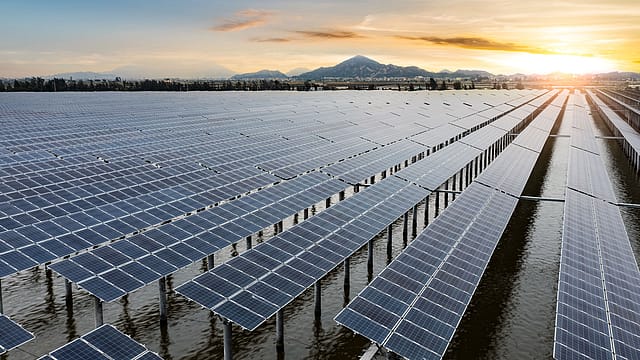Budget 2022: Power sector seeks big push for renewables, distribution
ADVERTISEMENT

Union finance minister Nirmala Sitharaman's Union Budget 2022-23 should focus more on accelerating initiatives and targeted policy changes to achieve the goal of 500 gigawatt renewable energy by 2030. A massive push for public mobility infrastructure, power distribution infrastructure and renewable capacity addition is required in the Budget, considering India's commitment to reduce carbon emissions, say industry experts.
In the 2021-22 budget, major provisions for the sector were Production Linked Incentive (PLI) scheme of ₹4,500 crore for high efficiency Solar PV modules (PLI scheme of nearly ₹1.97 lakh crore over five years starting FY 2021-22 for 13 sectors were announced in the budget). Under the PLI scheme, target was to have 10,000 megawatt capacity of integrated solar PV manufacturing plants (from manufacturing of wafer-ingot to high efficiency modules) with direct investment for around ₹14,000 crore. Further, the budget provided additional capital infusion of ₹1,000 crore to Solar Energy Corporation of India (SECI) and ₹1500 crore to Indian Renewable Energy Development Agency (IREDA). Capital Infusion in SECI was targeted to enable it to float 15,000 MW of tenders on a yearly basis and attract over ₹60,000 crore a year. Additional capital infusion in IREDA was targeted to provide an additional loan facility of ₹12,000 crore to fund RE projects. The budget also proposed to launch a Hydrogen Energy Mission in 2021-22 for generating hydrogen from green power sources.
Industry demands more provisions are required to achieve the targets. "Capital expenditure toward smart and clean infrastructure - including railways, power transmission and power grid upgradation - should be enhanced to create a multiplier effect in investments and create new employment opportunities to uplift the economy," says N Venu, managing director, Hitachi Energy India.
January 2026
Netflix, which has been in India for a decade, has successfully struck a balance between high-class premium content and pricing that attracts a range of customers. Find out how the U.S. streaming giant evolved in India, plus an exclusive interview with CEO Ted Sarandos. Also read about the Best Investments for 2026, and how rising growth and easing inflation will come in handy for finance minister Nirmala Sitharaman as she prepares Budget 2026.
Although India is making remarkable progress in meeting its ambitious renewable energy targets, the public e-mobility space leaves a lot of scope for charging infrastructure, as the country needs to add 400,000 stations by 2026 to meet India’s 2030 EV target. That is, adding more than 200 charging stations a day, he notes.
The industry also expects incentives and tax benefits for climate technology players who are enabling the development of sunrise sectors through new technologies -- the Internet of Things (IoT), machine learning and artificial intelligence (AI), Battery Energy Storage System (BESS), and more – and building the local manufacturing ecosystem and supply chain. Easier access to capital for such climate and tech companies, rationalisation of import duties especially in energy storage, green hydrogen and carbon capture technologies and tax incentives for development of the clean energy ecosystem are some of the expectations from this budget.
Pinaki Bhattacharrya, managing director and CEO of Amp Energy India, notes that despite supply disruptions, project schedules and timelines being affected due to Covid-19, India was able to reach 100 plus gigawatt (GW) of installed renewable capacity in 2021. With the 500 GW target, it is important to focus on reaching the 175 GW target in the next two years and increase deployment pace to 30 GW per year to reach 500 GW in nine years. For this, the government should provide soft loans to manufacturers and not impose artificial duties on developers, imposition of Basic Customs Duty (BCD) must be deferred by 3-6 months for the manufacturing capacity to be deployed in India and no more changes in taxes or duties and gradual reduction in the coming years, says Pinaki Bhattacharrya.
The domestic solar equipment industry also demands imposition of Basic Customs Duty (BCD) on solar cells and modules effective 1st April 2022. Increasing production-linked incentives (PLI) funding outlay for solar modules, enhanced export incentive - Remission of Duties or Taxes on Export Product (RoDTEP) rates and ensuring it includes AA (Advance Authorisation) along with SEZ, 5% interest subvention on term loans and working capital and upfront central financial assistance of 30% on capex are some of their recommendations to the Union finance minister.
Another suggestion is to allow a capital subsidy of 50% for setting up R&D and quality testing infrastructure within the manufacturing units and a super deduction of 200% for R&D expenses for solar technology development. "The budget must also consider allowing clearance from Special Economic Zones (SEZ) units to Domestic Tariff Areas (DTA) on a duty forgone basis. Additionally, we also recommend allowing conversion of SEZ units into DTA and permitting them to continue operating from the same infrastructure with enabling policies,” says Gyanesh Chaudhary, vice-chairman & managing director of Vikram Solar, India's leading solar equipment manufacturer.
